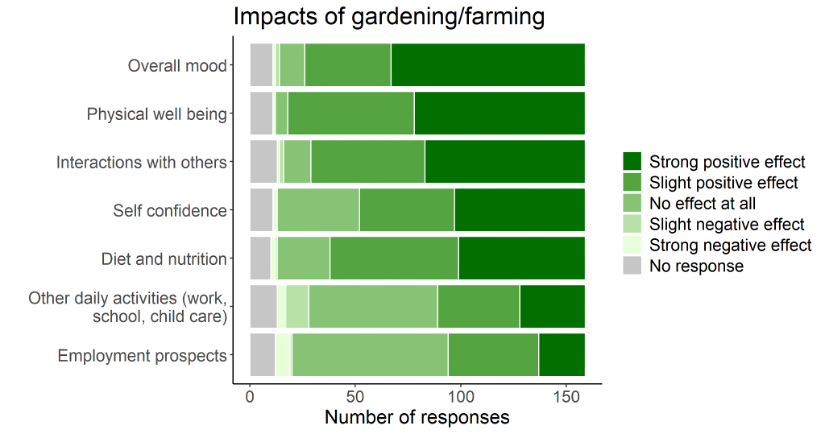What do we really know about urban agriculture’s impact on people, places, and the planet?
By Agnès Fargue-Lelièvre, Jason K. Hawes, Benjamin Goldstein, Lidia Poniży, Erica Dorr | May 7, 2024
What do we really know about urban agriculture’s impact on people, places, and the planet?
By Agnès Fargue-Lelièvre, Jason K. Hawes, Benjamin Goldstein, Lidia Poniży, Erica Dorr | May 7, 2024
Krystyna lives in a block of flats in Gorzów Wielkopolski, Poland. For the past 20 years she has looked forward to every spring, when she can spend her spare moments in her allotment plot.
On a sunny May morning, she walks briskly to her small garden. Upon arrival, she is greeted by the sights and smells of spring; almost half of the small space is filled with blooming flowers, as well as a few fruit trees that provide shade in the heat and tasty fruits in the fall. Vegetables fill the remaining space. Krystyna checks how much the kohlrabi has grown, and whether it is possible to pull out a lettuce for the first spring salad. She tends to her tomatoes in her small greenhouse, built using worn-out windows from a local school. At noon, she pauses for tea with a friend from the neighboring garden, chatting over a fresh salad spiced with Krystyna’s radishes and chives.
Around the same time in Paris, approximately 1,000 kilometers southwest of Krystyna’s garden, school children spill into their playground for an outdoor lunch, the usual basketball hoop and benches hemmed in by verdant raspberry bushes, artichokes, thyme, and tomatoes. Dozens of kids are gardening in their own small plots with the help of an urban farmer. Others play among the trees and by the pond that were put in place with the help of neighborhood volunteers.
For many city dwellers, these urban gardens are pocket-sized green oases in a sea of buildings and pavement that provide much-needed respite, crucial social connections as residents age, or fresh foods that might not appear in the corner store (Cohen and Reynolds 2016). These spaces also serve as communal meeting places and living classrooms that connect local children with nature. Urban gardens and farms can contribute to food security (Grard et al. 2015) and have important social and economic benefits (Ilieva et al. 2022).
The city- and food-system-level impacts of urban agriculture are less well understood (Caputo et al. 2021). This makes it difficult to assess some of the potential benefits of urban food growing, including its climate impacts. Recognizing this shortcoming, in 2018 we established a research program to investigate the relationships between urban agriculture and the interconnections of urban food, energy, and water systems, also called the “food-energy-water nexus.”
We studied the diverse economic, social, and food-energy-water nexus impacts of different types of urban agriculture in five countries: France, Germany, Poland, the United Kingdom, and the United States. Over the course of two growing seasons, in 2019 and 2020, we measured material inputs and outputs, such as yields, water and energy consumption, fertilizer, and farm infrastructure, but also social and economic benefits.
The team recruited gardeners and farmers from 73 urban agriculture sites, making it the largest study of its type to date. These 73 sites were diverse but could be generalized as low-tech urban agriculture, as opposed to high-tech urban agriculture that grow food in shipping container farms or plant factories that utilize hydroponics and climate control. Our sample included community farms and gardens, allotment gardens, home gardens, professional urban farms, and school gardens. Together with gardeners and farmers, we gathered qualitative and quantitative data on inputs and production, and we measured materials used for growing food such as timber for raised beds and plastic covers for poly-tunnels, also known as hoop houses. (See Figure 1.)

Participants overwhelmingly reported that urban agriculture improved their mood and physical well-being, self-confidence, community engagement, and, to a lesser degree, nutrition and diet. Participating in urban agriculture also increased awareness of the inextricable connection between food production and nature. For example, participants are apt to eat more in a more seasonally minded way, choosing fruits and vegetables adapted to the local climate, instead of imported out-of-season produce. (See Figure 2, below.)

At the same time, we showed that urban agriculture can have a nontrivial impact on cities’ food and water resource systems (Dorr et al. 2023). Across the 73 sites, food production by weight ranged between 0.2 and 6.6 kilograms per square meter, with a mean of 1.9 kilograms per square meter. The highest yields were in professional farms with greenhouses, although these farms also used the most water.
Urban agriculture, then, is an important resource for communities. And it has the potential to impact the food and water systems of cities in important ways. But climate change remains the defining environmental challenge of our age, and the unprecedented dataset developed as part of our research project allowed us to estimate the greenhouse gas dynamics of urban agriculture. This work was recently published in the academic journal Nature Cities (Hawes et al. 2024) and widely publicized by prominent news outlets including Forbes, Der Spiegel, and The Telegraph, who attempted to capture the essence of a very complex study in 10 words or less. As you might imagine, some outlets had more success than others at describing the nuances of urban agriculture. So, what did we really find out about the carbon footprint of urban agriculture, and what do these new findings tell us about how urban decision-makers can approach a practice with such complex impacts on cities and citizens?

Put simply, we found that urban agriculture cannot be assumed to be a magic climate solution. Instead, conscious design and planning choices must enable low-carbon agricultural production in cities. The headline, as has been reported in many media outlets, is that many urban agriculture sites today emit more greenhouse gases per kilogram of fruits and vegetables produced than conventional, large-scale agriculture providing produce to the same city. While this varied across the types of urban agriculture we studied (volunteer-led collective gardens, production-focused urban farms, and household-focused individual gardens), on average the carbon footprint of urban-produced fruits and veggies was six times that of conventional produce. Although this is contrary to the prevailing narrative that a primary benefit of urban agriculture is in slashing emissions by reducing “food miles”—the distance that food travels from its source to the place it is eaten—is consistent with more than a decade of research that has shown that short food-supply chains are not inherently less carbon-intensive than longer-distance farms.
Despite these findings, the outlook for urban agriculture remains bright, and there are plenty of reasons to continue farming in cities. Some types of urban agriculture, like professional urban farms, and some varieties of produce, especially those usually transported to cities by plane, had a lower carbon footprint than that of large-scale agriculture. Nearly a quarter of the sites (17 of our 73) produced food with a smaller carbon footprint than rural agriculture. By breaking down what sets these sites apart from the average urban agriculture facility, our study also identified best practices for low-carbon urban agriculture.
Specifically, we found that the most climate-friendly urban agriculture sites reuse city waste (like construction waste) to construct infrastructure like raised beds and pathways; have secure land tenure, allowing projects to recoup the initial carbon investment over the course of decades instead of the sometimes two- to three-year leases they are given; and prioritize high-carbon fruits and vegetables like those traditionally grown in greenhouses or flown in on planes.
Several studies of urban agriculture’s environmental footprints have already been done (Dorr et al. 2021), and their results are consistent with the body of evidence accumulated over years of study. But most studies conducted to date have only assessed a handful of farms and have mainly focused on high-tech production with high energy consumption and high initial investments. It is, frankly, much less surprising to say that lettuce grown by consuming a lot of coal- or natural gas-fueled electricity is high-carbon than to say the same thing about lettuce from a simple raised bed.
Of course, urban agriculture is currently not present on a grand scale in our five case countries but if we want urban agriculture to grow—and there are a lot of other benefits that justify its continued proliferation—it must be designed to be carbon-friendly. The book Beyond the Kale (Cohen and Reynolds 2016) also pointed out that urban agriculture does not inherently advance equity or social justice. These benefits and co-benefits must be designed into urban agriculture’s practices and physical spaces.
Urban farms and gardens can bring many benefits that have been documented in our study and others—social and cultural improvements, biodiversity, green corridors, and stormwater absorption—and should be measured against the opportunity costs, or likely alternative uses of urban land, which may be much more carbon-intensive or bad for the environment in other ways.
As for other benefits, like curbing greenhouse gas emissions or mitigating heat with rooftop gardens (green roofs), recent studies have shown that they hinge on the kind of urban agriculture or green roof and should not be assumed but studied. In the same way, further study is still needed on how urban gardening influences shopping practices, consumer travel patterns (e.g., to urban farming sites), food-waste generation rates, and other spillover effects.
Urban agriculture can play a role in helping cities fight and adapt to climate change, but to do so in a low-carbon way requires municipal governments to provide support so farms can operate for decades (not years); training for farmers to carefully source and efficiently use resources; and judicious crop selection. Urban agriculture can help feed cities, but it can do much more than that. There are ways to foster urban agriculture that make cities greener, happier, and healthier.

Urban agriculture has many benefits, but as with any technology or practice, there is plenty of room for innovation and improvement. To borrow the words of a famous fantasy writer, Mercedes Lackey, “There is no one true way.” Urban agriculture in its multiple manifestations can be one of the tools to help cities become more sustainable and resilient.
Our research underscores the importance of finding the right urban agriculture for the right urban space. So, for those folks excited about the future of urban agriculture but alarmed by our recent findings—please, do not tear out your raised bed, but do advocate for more comprehensive city planning and policies that can support more robust, low-carbon urban gardens and farms.
Funding
The FEW-meter project has received funding from the European Union’s Horizon 2020 research and innovation program (GA No. 730254) under the Belmont Forum and JPI Urban Europe’s call SUGI—FWE Nexus, and the ANR, France, grant number ANR-17-SUGI-0001-01; BMBF, Germany, grant number 01LF1801A; National Science Centre, Poland, grant number 2017/25/Z/HS4/03048; ESRC, UK, grant number ES/S002170/2; NSF, USA, Belmont Forum 18929627.
Acknowledgements
We would like to thank all the gardeners and farmers in France, Germany, Poland, the United Kingdom, and the United States, who diligently collected data on food production and resource use during two growing seasons in 2019 and 2020, filled out social and behavioral surveys, and allowed researchers to visit their gardens so that they could take measurements.
Together, we make the world safer.
The Bulletin elevates expert voices above the noise. But as an independent nonprofit organization, our operations depend on the support of readers like you. Help us continue to deliver quality journalism that holds leaders accountable. Your support of our work at any level is important. In return, we promise our coverage will be understandable, influential, vigilant, solution-oriented, and fair-minded. Together we can make a difference.
Keywords: Carbon emissions, climate crisis, food security, rooftop farm, urban agriculture, urban farming
Topics: Climate Change, Special Topics

























